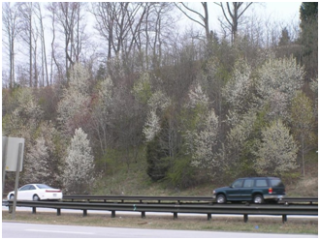Traveling in early spring along the Washington Beltway is always a reminder of the  unstoppable blob that is wreaking havoc across the landscape.
unstoppable blob that is wreaking havoc across the landscape.
I am not talking about a tsunami of boiling mud from a 1950s black and white horror movie, but the modern scourge of Bradford pear. When these ornamental pear trees are blooming, we realize how prevalent they are in the landscape. They once only lined city streets. But now those urban renewal plantings have escaped into natural areas. Planting street alleés of Bradford pear has changed the landscape of major byways in the region, lining them with woodland thickets of Bradford pears. Is there a budget large enough to stop the march of Bradford pears across the landscape?
A decade ago I asked a horticulturist, whose family owns one of the region’s oldest and largest retail nurseries in a DC Beltway community, how he had become so exorcised about invasive non-native plants. He said a walk through Rock Creek Park convinced him the problem is urgent. The banks of Rock Creek are covered in the worst offenders: Japanese honeysuckle, multiflora rose, knotweed, Oriental bittersweet, stilt grass, and garlic mustard are invasive non-native plants that threaten the survival of native plants. A spring drive along Route 50 and around the Beltway should be enough to convince the most uninformed that something sinister is spreading white blossoms everywhere. What can we do? Refuse to be a culprit and stop growing, selling, and planting Bradford pears.
by Ellie Altman
Executive Director
